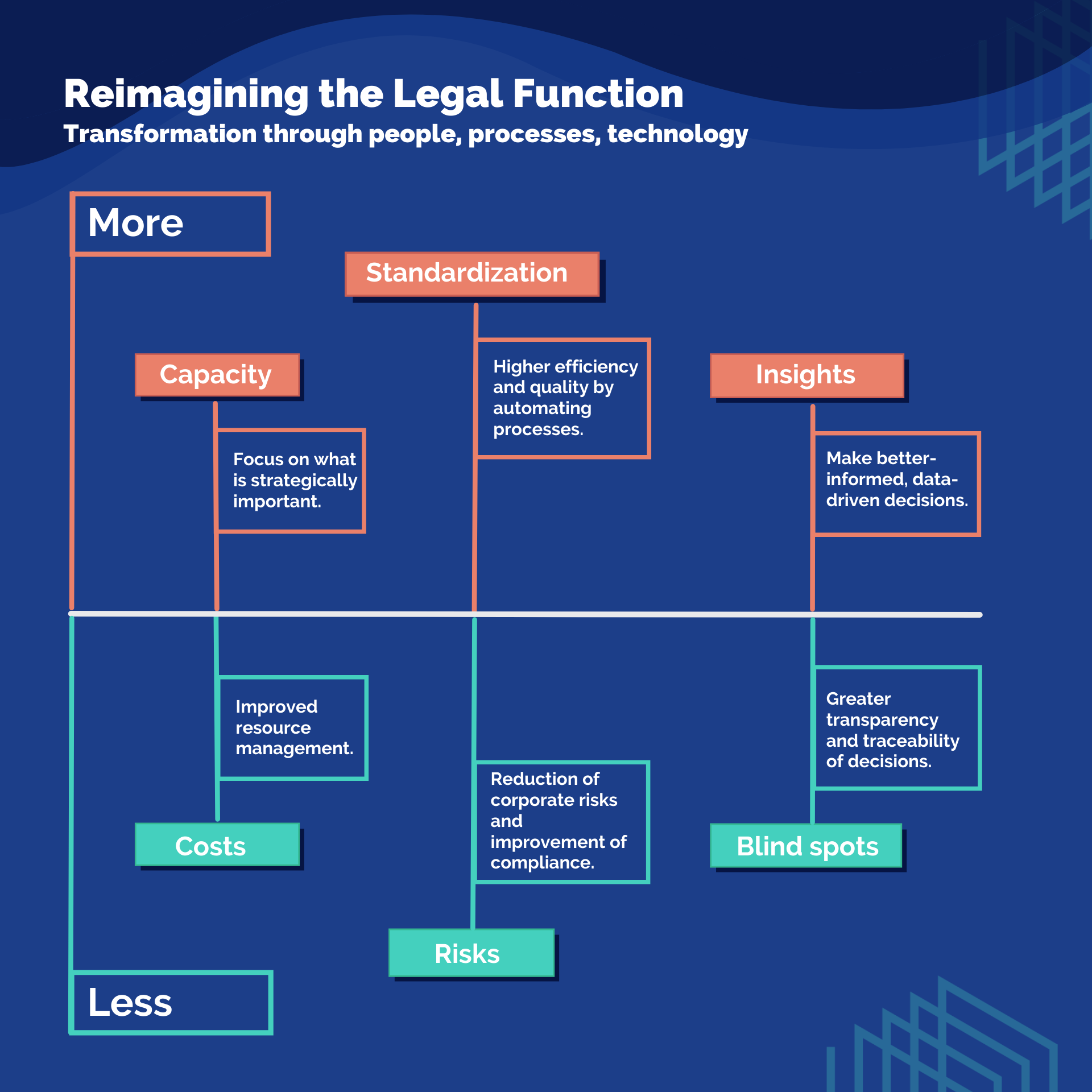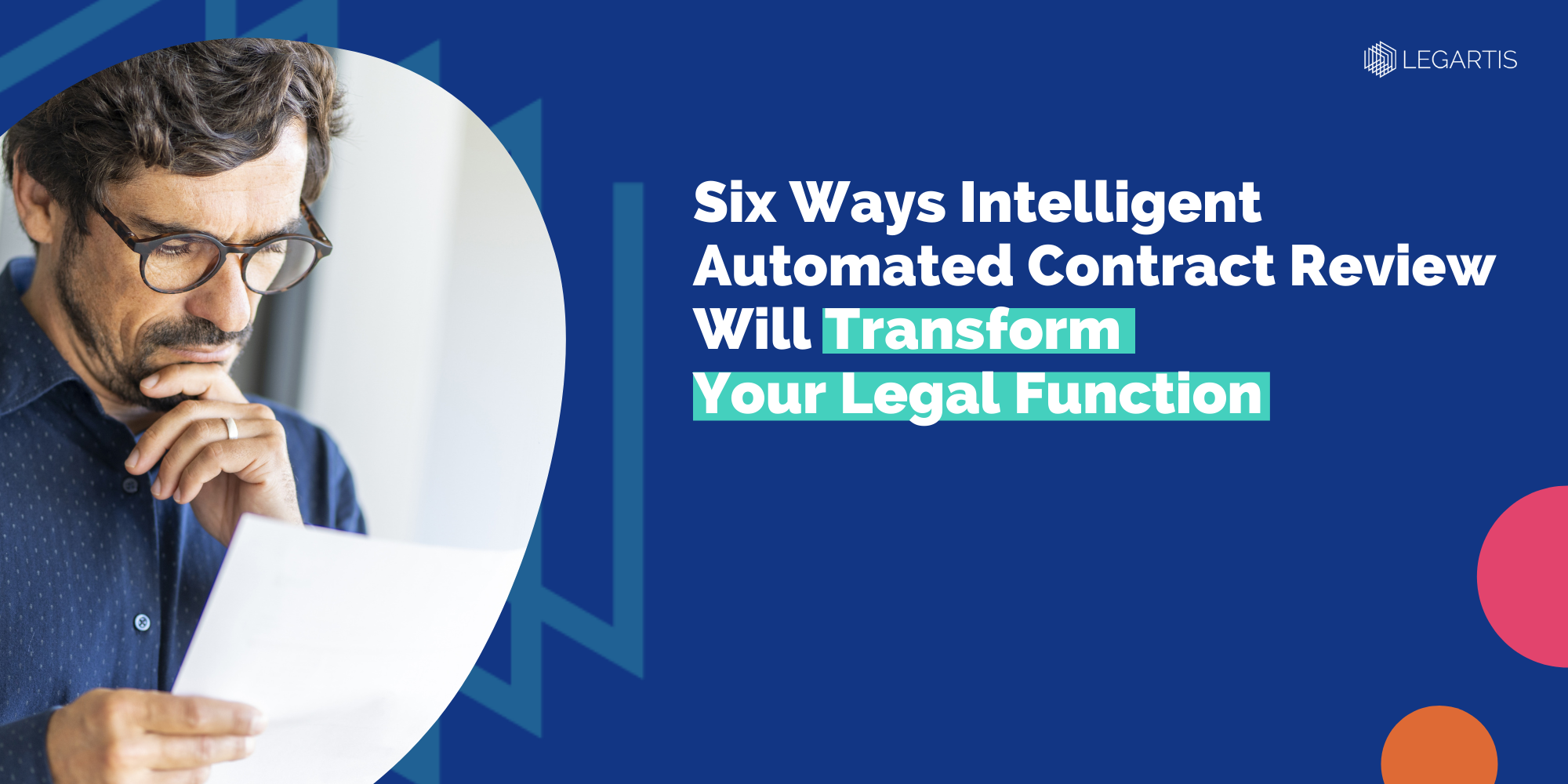The legal function changes
AI and automation can help legal departments, and therefore legal counsels and general counsels, to elevate the role of the legal function. This is especially true for automated contract review software, which can enable legal departments to manage exponentially-increasing workloads, perform more efficiently, and deliver higher-quality results thanks to standardization. The impact of new technologies such as AI in contract reviews can be genuinely game-changing, helping to drive the transformation of legal from simply providing cost-efficient legal advice into a corporate value driver.
Here are six ways automated contract review software delivers urgently-needed improvements in legal department efficiency and quality. While laying the foundations for creating an agile digital corporate legal department.
 1. Free up capacity and accelerate workflows
1. Free up capacity and accelerate workflows
A global EY survey of over 1,000 legal practitioners found that legal teams spend more than a quarter of their time (27%) on repetitive and routine tasks like reviewing sales agreements, non-disclosure agreements (NDA) and blanket purchase agreements (BPA).
But internal business partners in functions like Sales and Procurement are demanding that their contracts are reviewed ever more quickly in response to commercial pressures. This leaves legal teams with little or no time to focus on higher-value strategic work.
Automating these routine tasks offers a quick win in removing legal bottlenecks, and changing the perception of the legal department as a drag on the business.
2. Standardize routine tasks
Businesses are expecting their legal teams to provide more and more customized guidance, but without extra capacity this demand is unsustainable.
By standardizing and automating common contractual tasks, legal teams can free up the capacity they need to provide customized advice on complex bespoke contracts. Contract review tasks that are often very similar are ideally suited to automation. These include NDAs, data processing agreements (DPA), general terms and conditions (GTC), and sales or procurement agreements.
In addition, an automated contract review process delivers continuously high quality and maintains alignment with important corporate guidelines.
As KPMG puts it, ‘streamlined, standardized and automated processes reduce risk and increase efficiency, enabling your lawyers to focus on what matters most: delivering value.’
3. Gain objective commercial insights
As legal heads look for ways to add strategic value to the business, automation platforms are a great source of analytics and insights. These enable businesses to make data-driven decisions based on objective facts rather than subjective opinions.
Analyzing trends, volumes of work and areas of recurring risk enable you to refine services and maintain a virtuous circle of continuous improvement within your department. Just as valuably, by analyzing changing trends in legal contracts within the business, you'll help to make legal more flexible and adaptive to business needs.
4. Drive down costs
Legal teams everywhere are expected to do more with less.
In EY’s view, ‘legal functions are reaching a critical point in their ability to deliver effective legal services as cost pressures will not abate over the next few years.’
Some early and more complex contract management solutions led to unexpected costs because they were difficult for legal teams to use, or required intensive and expensive training. In contrast, modern AI contract review solutions, integrate seamlessly into familiar tech environments such as Microsoft 365. So as well as enabling legal teams to make smarter use of resources, they deliver a fast time to value.
5. Reduce risks
More complex stakeholder demands, and increasing workloads, have all piled pressure on the contract processing function. As contract review workloads become overwhelming, the risk of human error grows too, which increases the likelihood that some contracts can no longer be properly reviewed, and will slip out of the contract review grid.
With automated contract reviews, company policies and standard contractual clauses are defined for each contract. This takes away the risk of human error when work volumes are especially high, contracts are exceptionally complex, and over-worked people are tired and error-prove.
6. Eliminating blind spots
Manual oversight is always subject to errors. In contrast, automation brings greater transparency and traceability of decision-making in every part of the contract review process. In extreme cases, where pressure of work has meant contracts have not been properly reviewed, leading to an unmanaged liability, automation can quickly identify and eliminate these hazardous blind spots.
Discover the full potential of the Legal AI of Legartis. Request a demo now.
Next steps
If you would like to take a closer look at how legal departments benefit from AI in contract review read the HAWE Hydraulik case study.
Recommended Articles
Trends 2025: AI in Contract Analysis
The latest trends in Large Language Models (LLMs) show a shift towards greater efficiency, advanced AI agents and wider adoption across all industries. AI models are becoming..
KPIs in Contract Review
KPIs (Key Performance Indicators) are indicators that are used to measure performance and determine whether specified targets are being achieved. This applies to companies,..
Legal AI Talk: Latest Large Language Model Trends
AI and Large Language Models (LLMs) are revolutionizing the legal industry, streamlining contract analysis, document automation, and research with greater precision...





